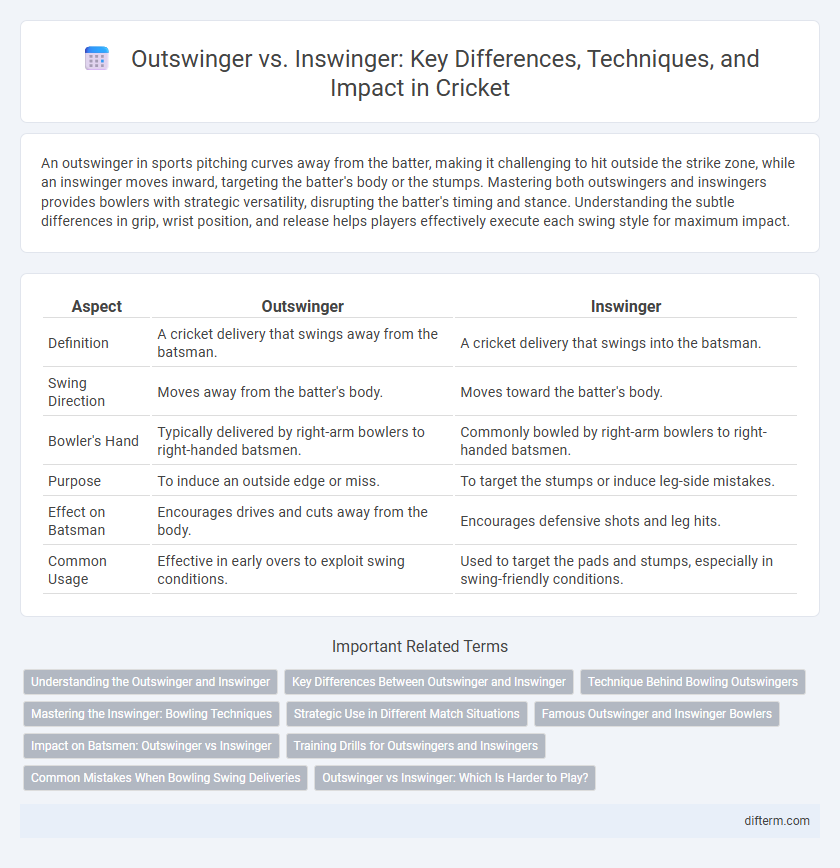An outswinger in sports pitching curves away from the batter, making it challenging to hit outside the strike zone, while an inswinger moves inward, targeting the batter's body or the stumps. Mastering both outswingers and inswingers provides bowlers with strategic versatility, disrupting the batter's timing and stance. Understanding the subtle differences in grip, wrist position, and release helps players effectively execute each swing style for maximum impact.
Table of Comparison
| Aspect | Outswinger | Inswinger |
|---|---|---|
| Definition | A cricket delivery that swings away from the batsman. | A cricket delivery that swings into the batsman. |
| Swing Direction | Moves away from the batter's body. | Moves toward the batter's body. |
| Bowler's Hand | Typically delivered by right-arm bowlers to right-handed batsmen. | Commonly bowled by right-arm bowlers to right-handed batsmen. |
| Purpose | To induce an outside edge or miss. | To target the stumps or induce leg-side mistakes. |
| Effect on Batsman | Encourages drives and cuts away from the body. | Encourages defensive shots and leg hits. |
| Common Usage | Effective in early overs to exploit swing conditions. | Used to target the pads and stumps, especially in swing-friendly conditions. |
Understanding the Outswinger and Inswinger
The outswinger and inswinger are two fundamental types of swing bowling techniques in cricket, each manipulating the ball's trajectory through the air to deceive the batsman. An outswinger moves away from the batsman, typically delivered by a right-arm bowler to a right-handed batsman, by angling the seam and using the shiny side of the ball to generate lateral movement. Conversely, an inswinger moves into the batsman, utilizing the opposite seam position and airflow dynamics, making it a strategic tool for targeting the pads and inducing leg before wicket (LBW) dismissals.
Key Differences Between Outswinger and Inswinger
Outswingers in cricket curve away from the batsman, moving from leg to off stump for a right-handed batsman, while inswingers move inward, targeting the pads or stumps. The grip, wrist position, and seam orientation primarily distinguish the two, with outswingers having the seam angled towards the slips and inswingers angled towards leg slip. Mastery over these deliveries influences bowling strategies, with outswingers often used to induce edges and inswingers to trap batsmen lbw or bowled.
Technique Behind Bowling Outswingers
Bowling an outswinger requires precise wrist position and seam orientation, with the seam angled slightly towards the slips to guide the ball away from the batsman. The bowler must maintain a strong, upright wrist and release the ball with the seam upright and the fingers positioned to allow air to flow differently on each side of the ball, creating lateral movement. This technique exploits aerodynamics, generating swing by altering air pressure, making the outswinger a challenging delivery to face in cricket.
Mastering the Inswinger: Bowling Techniques
Mastering the inswinger requires precise wrist position and seam orientation, with the shiny side of the ball angled towards the leg side to maximize swing towards the batsman's pads. Bowlers must deliver the ball with a slightly raised and angled seam while maintaining a smooth, controlled release to generate late movement. Consistent practice of these bowling techniques enhances accuracy and increases the chances of dismissing right-handed batsmen by targeting the stumps or inducing leg-side edges.
Strategic Use in Different Match Situations
Outswingers are strategically used to lure batsmen into driving outside the off stump, increasing chances of edges to slips in defensive conditions or when quick wickets are needed. Inswingers target the stumps or pads, creating LBW or bowled opportunities, particularly effective in matches where pitch conditions favor swing bowling or when attacking a set batsman. Teams often alternate between outswingers and inswingers to maintain unpredictability and exploit batsman weaknesses based on match situations.
Famous Outswinger and Inswinger Bowlers
Famous outswinger bowlers include James Anderson, renowned for his ability to move the ball away from right-handed batsmen with precision swing bowling. In contrast, iconic inswinger bowlers like Glenn McGrath utilized late movement into the batsman to create seam-up deliveries that consistently troubled top-order batsmen worldwide. Both styles demand mastery of wrist position and seam orientation to exploit atmospheric conditions effectively.
Impact on Batsmen: Outswinger vs Inswinger
Outswingers challenge batsmen by moving away from the bat, increasing the risk of edges and slips catches, particularly against right-handed players. Inswingers, swinging into the batsman, create opportunities for bowled or LBW dismissals by targeting the stumps more directly. The contrasting swing directions force batsmen to continually adjust their shots and footwork, impacting overall scoring strategies.
Training Drills for Outswingers and Inswingers
Training drills for outswingers focus on wrist position and seam alignment to create the ball's movement away from the batsman, emphasizing control and accuracy through repetitive swing practice. Inswinger drills prioritize the inward swing by adjusting grip and angle of release, often incorporating target-based exercises to enhance precision and consistency in moving the ball toward the stumps. Both types of bowling benefit from video analysis and simulated match scenarios to refine swing mechanics and situational application.
Common Mistakes When Bowling Swing Deliveries
Common mistakes when bowling outswingers and inswingers include incorrect seam position, which reduces the ball's ability to swing effectively. Bowlers often fail to maintain a consistent wrist position, leading to a lack of control and unpredictability in swing movement. Poor release mechanics and inconsistent pace further diminish the effectiveness of swing deliveries, making them easier for batsmen to predict and counter.
Outswinger vs Inswinger: Which Is Harder to Play?
Outswingers swing away from the batsman, challenging their outside edge and demanding precise judgment to avoid edges to the slip cordon, while inswingers move into the batsman, increasing the risk of LBW and bowled dismissals. Many players find outswingers harder to play due to the lateral movement away from the body, forcing off-balance shots that lead to catches. Conversely, inswingers require careful forward defense and pad awareness, but their trajectory often encourages more controlled stroke play, making outswingers generally more challenging at higher levels.
Outswinger vs Inswinger Infographic

 difterm.com
difterm.com